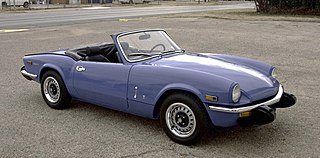
Puma is a sports car manufacturer based in South Africa. Puma was originally based in Brazil where it built cars, from 1964 until roughly 1995, and trucks, from 1978 to 1999. The company then re-opened in South Africa in 2013 under the name of Puma Automobiles. Puma Automobiles manufactures the Puma 52 and the Puma GT 2.4 Lumimari.

Berkeley Cars Ltd of Biggleswade, Bedfordshire, England produced economical sporting microcars with motorcycle-derived engines from 322 cc to 692 cc and front wheel drive between 1956 and 1960.
The Atalanta was an English automobile manufactured from 1937 until 1939 by Atalanta Motors Ltd in Staines, Middlesex. Two models were made.

The Triumph Herald is a small two-door car introduced by Standard-Triumph of Coventry in 1959 and made through to 1971. The body design was by the Italian stylist Giovanni Michelotti, and the car was offered in saloon, convertible, coupé, estate and van models, with the latter marketed as the Triumph Courier.

Singer Motors Limited was a British motor vehicle manufacturing business, originally a bicycle manufacturer founded as Singer & Co by George Singer, in 1874 in Coventry, England. Singer & Co's bicycle manufacture continued. From 1901 George Singer's Singer Motor Co made cars and commercial vehicles.

The Mazda B series is a series of pickup trucks first manufactured in 1961 by Mazda. Since the launch of the B series, Mazda has used the engine displacement to determine each model's name; the B1500 had a 1.5 L engine and the B2600 had a 2.6 L engine. In Japan, the name Mazda Proceed was used for the compact pickup. Other names used for this line include Mazda Bravo (Australia), Mazda Bounty, Mazda Magnum/Thunder/Fighter (Thailand), and Mazda Drifter.

Elva was a sports and racing car manufacturing company based in Bexhill, then Hastings and Rye, East Sussex, United Kingdom. The company was founded in 1955 by Frank G. Nichols. The name comes from the French phrase elle va.

Albion Motors was a Scottish automobile and commercial vehicle manufacturer.

Fairthorpe cars were made in Chalfont St Peter, Buckinghamshire, England between 1954 and 1961, from 1961 to 1973 in Denham, Buckinghamshire.
Ginetta Cars is a British specialist builder of racing and sports cars based in Garforth, Leeds, West Yorkshire.

The Rolls-Royce Silver Ghost name refers both to a car model and one specific car from that series.

Rochdale cars were a series of mainly glass fibre bodied British sports car made by Rochdale Motor Panels and Engineering in Rochdale, Greater Manchester, England between 1948 and 1973. The company is best remembered for the Olympic coupé made between 1959 and 1973.

Turner Sports Car Company Limited was a 1950s British sports car manufacturer, that closed in 1966.

The Leyland Eight was a luxury car produced by Leyland Motors from 1920 to 1923.

The Vale Special was a British sports car made between 1932 and 1935 in Maida Vale, London.
The Perry was a British car made by the Perry Motor Company based in Tyseley, Birmingham who made cars between 1913 and 1916.
The SA was Toyota's first new passenger car design after World War II. It was the first in a family of vehicles before the introduction of the Crown. A series of light trucks also shared the chassis and major components of these passenger cars.

Straker-Squire was a British automobile manufacturer based in Bristol, and later Edmonton in North London.

The Gentry is a British kit car styled to resemble a MG TF. It was offered for sale to the public by RMB Motors of Barwell, Leicestershire from 1974, the original prototype having been completed at the end of 1973. 15 kits were supplied in this first year, rising to over 80 per year produced in 1979.
Automobiles Stabilia was an automobile manufacturer based on the north side of Paris between 1906 and 1930. Although the name of the company changed a couple of times, the cars were branded with the Stabilia name throughout this period. The company specialised in lowered cars featuring a special patented type of suspension.



















